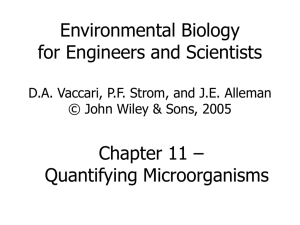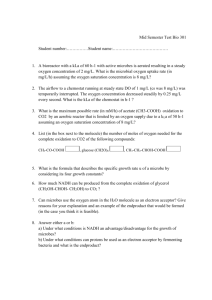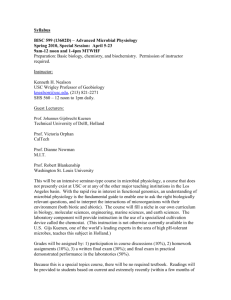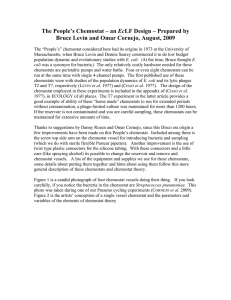Michael Banco
advertisement
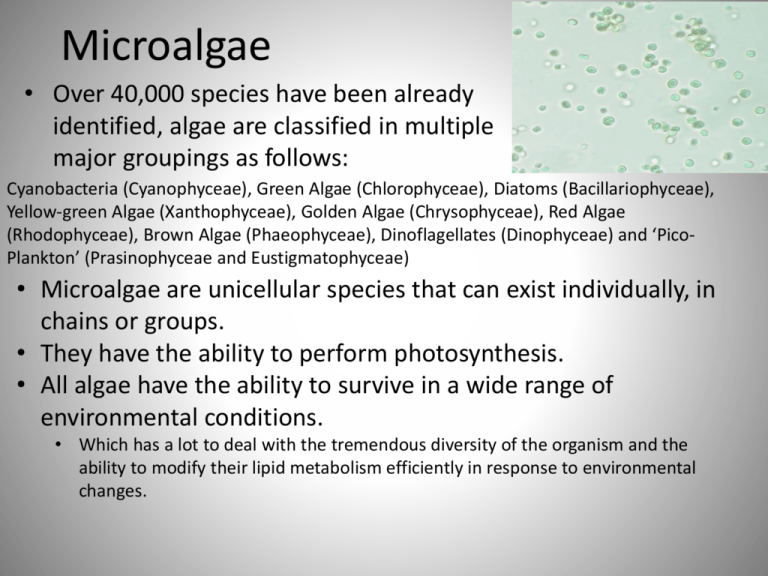
Microalgae • Over 40,000 species have been already identified, algae are classified in multiple major groupings as follows: Cyanobacteria (Cyanophyceae), Green Algae (Chlorophyceae), Diatoms (Bacillariophyceae), Yellow-green Algae (Xanthophyceae), Golden Algae (Chrysophyceae), Red Algae (Rhodophyceae), Brown Algae (Phaeophyceae), Dinoflagellates (Dinophyceae) and ‘PicoPlankton’ (Prasinophyceae and Eustigmatophyceae) • Microalgae are unicellular species that can exist individually, in chains or groups. • They have the ability to perform photosynthesis. • All algae have the ability to survive in a wide range of environmental conditions. • Which has a lot to deal with the tremendous diversity of the organism and the ability to modify their lipid metabolism efficiently in response to environmental changes. Microalgae: The ‘drop-in’ substitutes for petroleum-based liquid fuels. • Microalgae can form triacylglycerols(TAGs). – Under unfavorable environmental or stress conditions for growth, algae will alter their lipid biosynthetic pathways towards the formation and accumulation of neutral lipids, mainly in the form of TAGs. – TAGs are not part of any structural components for the cell. But are stored for energy in densely packed lipid bodies stored in the cytoplasm for energy. • TAGs can undergo an transesterification reaction to produce alkyl alcohols. – Shown in the 1980’s. – Alkyl alcohols have properties that are the same as petroleum! Potential advantages of using algae as feedstocks for biofuel and biomaterials. 1. 2. 3. 4. 5. 6. 7. Synthesize and accumulate large quantities of neutral lipids/oil. Grow at high rates (e.g. 1–3 doublings per day). Thrive in saline/brackish water/coastal seawater for which there are few competing demands. Tolerate marginal lands (e.g. desert, arid- and semi-arid lands) that are not suitable for conventional agriculture. Utilize growth nutrients such as nitrogen and phosphorus from a variety of wastewater sources (e.g. agricultural run-off, concentrated animal feed operations, and industrial and municipal wastewaters), providing the additional benefit of wastewater bio-remediation. Sequester carbon dioxide from flue gases emitted from fossil fuel-fired power plants and other sources, thereby reducing emissions of a major greenhouse gas. Produce value-added co-products or by-products (e.g. biopolymers, proteins, polysaccharides, pigments, animal feed, fertilizer and H2). Assessment of bioenergy and bioremediation potentials of the microalga Scenedesmus sp. AMDD cultivated in municipal wastewater effluent in batch and continuous mode. Patrick J. McGinn, Kathryn E. Dickson, Kyoung C. Park, Crystal G. Whitney, Scott P. MacQuarrie, Frank J. Black, Jean-Claude Frigon, Serge R. Guiot, Stephen J.B. O’Leary Objectives for the study: 1. To investigate the used of secondary waste water effluent from a municipal wastewater treatment plant as a source of nutrition for intensive microalgae growth. - Secondary effluent is the end result of the treatment process and typically discharged into receiving waters. Drinking water….. 2. To address the issue of productive and stable cultivation of microalgae in continuous chemostats at a high dilution rate. Microalgae strain used: Scenedesmus sp. AMDD • This is very general algae in freshwater. • The cells are arranged in a row to for 4 or 8 celled colonies. 2 to 16 celled colonies can occur and very rarely there are more than 16 cells per colony. • The cells for this study was isolated from soil samples and identified by standard DNA sequencing (courtesy of the NRC Plant Biotechnology Institute). • The microalgae cells were transported in standard Bold’s Basal medium at 20 C in low light until inoculation. Two types of reactors were used! Diagram A: These are batch reactors called brite box photobioreactors. Diagram B: This is the continuous reactor using a chemostat. *Samples for wastewater was collected in April, May and August of 2011 from the Mill Cove wastewater treatment plant. Brite-Box photobioreactor • The study's photobioreactor: • 300L enclosed fiberglass shell • Media: Wastewater from the 3 separate months previously mentioned. • Sterilized by 40W UV irradiation system (on site) and than pass through a tangential flow ultrafiltration system (at the lab) • CO2 was used a buffer incase the pH exceeded the 3 set points. • Carbon dioxide was the only nutrient added to the cultures. • Mixing was provided by aeration by a sterilized air. • A cooling mechanism was also installed if the temperature exceed 25 C • A titanium heat exchange loop pumped with cool sea water. Continuous batch (Chemostat) • The Features: • 2L vessel • Wastewater from August was only used in the chemostat. • Same sterilization as Photobioreactor, but was also autoclaved. • pH of chemostat was maintained at 7.0 only, and monitored with carbon dioxide. • The chemostat was started as a batch reactor first! Once cells were in the late log phase (day 4) than chemostat was started. • The dilution rate was set to 0.94 mL/min. • Once chemostat was started, an output for pumping media out was also turned on. • This is prevent overconsumption of culture for the system. • Chemostat was considered to be at a steady state IF cell biomass measured from output was consisted for 3 days. • Not greater than 10%. • Temperature was maintained at 21 C by a circulating water bath • Light was provided continuously from one side by a bank of fluorescent lights. Analysis!! • Microalgae growth and biomass analysis: – About 10-200mL of culture was taken daily from each culture and filtered onto on a preweighed glass fiber filter (GF filter). – After filtration cells were washed with distilled water and than freezed dried overnight in a lyophilizer. Than weighed the next day. Specific Growth Rate: Biomass productivity: Gas Chromatography used to analyze fat yields in biomass. Analysis!! Cont. • Elemental analysis of biomass: • Vario Microcube elemental analyzer • Used to calculate elemental C, H, N and S. • Phosophrous was measured using a commercial assay. • Samples were disgested, cooled with color developing regant added, and than read on a spectrophotometer at 890nm. • Metal analysis of bio mass using a inductively coupled plasma-mass spectrometry (ICP-MS) • Digesting cells in concentrated nitric acid and than analysis. Batch cultures Results/Discussion! Chemostats • Chemostats lasted longer however than batch cultures lasting 12 weeks. Results/Discussion! Batch cultures Chemostat Initial concentrations of wastewater • Batch reaction did have a higher maximum growth rate than the chemostat did. However the chemostat had a higher growth productivity. • Both reactors shown complete removal of nitrogen and phosphorus from the wastewater. • However retention time is higher having the cells intake more of the elements. – Chemostat was 5 times shorter than the batch cultural. • Fatty acid yields were low as well in both reactors. – However having a high dilution rate could have effected the rate of TAG production. Results/Discussion! Trace elements were that were also shown to have a significant uptake as well. Problems with study: 1. Chemostat and Batch reactor should have been consistent in design and experiments to compare each other: 1. The chemostat wasn’t tested for all 3 months. It was only tested in the month for August. 2. The chemostat and the batch reactor needed to be actually the same. What I mean is that the batch reactor used a aeration system to stir while the chemostat used a stir plate to mix. Small differences can change the data greatly. 2. For the chemostat, it was performed with 7.0 pH. While in the paper it mentions that carbon dioxide is best transferred to the cells at pH 6.2 (when it’s higher it’s transferred as bicarbonate). Since algae are photosynthetic organisms that depend on carbon dioxide, the chemostat should have been set to 6.2 rather than 7.0. 3. HPLC could have been used instead of GC to measure fatty acids. 1. A major advantage can be that HPLC operates at ambient temperature so there is relatively little risk to sensitive functional groups 4. Try to do a better job at sterilizing their reactors. 1. Data for the batch reactor might be biased. This is because the reactors were contaminated with algal grazers. 5. Low yields of fatty acids or TAGs. 1. In some studies they suggest that providing environmental stress can create higher TAGs. There was no form of environmental stress placed on the microalgae. Work cited 1. 2. 3. 4. 5. Fresh water life. Web. 3 Dec. 2012. http://www.freshwaterlife.org/imagearchive/main.php?g2_itemId=1031 5. J.T. Sheehan, J. Dunahay, J.R. Benemann, P.G. Roessler, A look back at the US Department of Energy’s Aquatic Species Program – biodiesel from algae, http://www.nrel.gov/biomass/pdfs/24190.pdf 1998. Hu, Qiang, Milton Sommerfeld, Eric Jarvis, Maria Ghirardi, and Matthew Posewitz. "Microalgal triacylglycerols as feedstocks for biofuel production: perspectives and advances." The Plant Journal 54.4 (2008): 261-693. Web. 3 Dec. 2012. Christie, William. "ANALYSIS OF FATTY ACIDS BY HIGH-PERFORMANCE LIQUID CHROMATOGRAPHY." Lipid Technology (1997): 124-26. Web. 3 Dec. 2012. <http://lipidlibrary.aocs.org/topics/fa_hplc/index.htm>. Chen, Zhuo, Yangmin Gong, Xiantao Fang, and Hanhua Hu. "Scenedesmus sp. NJ-1 isolated from Antarctica: a suitable renewable lipid source for biodiesel production." World Journal of Microbiology and Biotechnology 28.11 (2012): 3219-25. Web. 3 Dec. 2012. <http://link.springer.com/article/10.1007%2Fs11274-012-1132-0>. Note to self: Always review a journal article before getting it approved for a 15 minute presentation! Making sure keywords of your assigned topic is in the title doesn't mean you've review it. But do you have any questions, comments, concerns, disappointments, or confusion?
